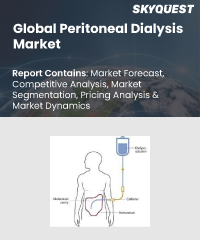
Report ID: SQMIG35D2183

Report ID:
SQMIG35D2183 |
Region:
Global |
Published Date: February, 2024
Pages:
157
|
Tables:
87 |
Figures:
77
Global Peritoneal Dialysis Market size was valued at USD 76.9 billion in 2019 and is poised to grow from USD 81.8 billion in 2023 to USD 126.43 billion by 2031, growing at a CAGR of 6.4% in the forecast period (2024-2031).
When your kidneys are no longer able to effectively complete the job, peritoneal dialysis is a treatment option. Compared to hemodialysis, which is a more popular blood-filtering method, this process filters the blood in a different way. A cleaning solution is injected into a portion of your abdomen via a catheter during peritoneal dialysis. Your peritoneum, which lines your belly, functions as a filter to take waste materials out of your blood. The fluid containing the filtered waste items flows out of your abdomen and is expelled after a certain amount of time. One of the treatments for kidney failure with the quickest rate of growth is peritoneal dialysis (PD), which is preferable for patients who still have some renal function and can tolerate the rapid changes in fluid balance brought on by hemodialysis. PD provides flexible treatment options and minimizes trips to the dialyzer. The advantages of choosing PD home dialysis include improved outcomes, fewer drugs, and fewer dietary restrictions. Patients may simply check themselves at all times when doing peritoneal dialysis at home without help. These benefits have increased the popularity of PD among renal patients today and will continue to support the peritoneal dialysis market throughout the projected period.
The majority of older patients with end-stage renal illness receiving PD therapy have varying degrees of accessibility, expertise, and technical education. Many older cycler patients' aversion to using them and their technophobia is seen as commercial limitations. Patients with end-stage kidney disease (ESKD) lasting fewer than two years had a rise in home dialysis use from 14.8 percent in 2023 to 20.0 percent in 2019, with PD accounting for more than 90% of total use. The use of home dialysis increased from 11.7 percent in 2023 to 13.7 percent in 2019 among patients with ESKD lasting 2 to 4 years. The increase in dialysis is expected to boost the growth of the global peritoneal dialysis market during the forecast period.
The global peritoneal dialysis market had been severely disrupted by the COVID-19 pandemic. Due to pandemic's high hospitalization rates, the need for dialysis equipment and supplies has suddenly increased. The greater frequency of coexisting diseases including CKD, diabetes, and hypertension was primarily to blame for this. The epidemic also caused significant supply-chain disruptions, which made it difficult for producers to keep up with demand. The ageing population's increasing medical demands, the increased demand for novel goods and treatments, and developments in medical technology are all predicted to contribute to the market's continued expansion after COVID-19. Additionally, increasing governmental and commercial sector initiatives to promote home HD/PD may open up more lucrative market prospects after COVID-19.
US Peritoneal Dialysis Market is poised to grow at a sustainable CAGR for the next forecast year.
Our industry expert will work with you to provide you with customized data in a short amount of time.
REQUEST FREE CUSTOMIZATIONPeritoneal Dialysis Market size was valued at USD 76.9 billion in 2019 and is poised to grow from USD 81.8 billion in 2023 to USD 126.43 billion by 2031, growing at a CAGR of 6.4% in the forecast period (2024-2031).
Want to customize this report? This report can be personalized according to your needs. Our analysts and industry experts will work directly with you to understand your requirements and provide you with customized data in a short amount of time. We offer $1000 worth of FREE customization at the time of purchase.

Report ID: SQMIG35D2183